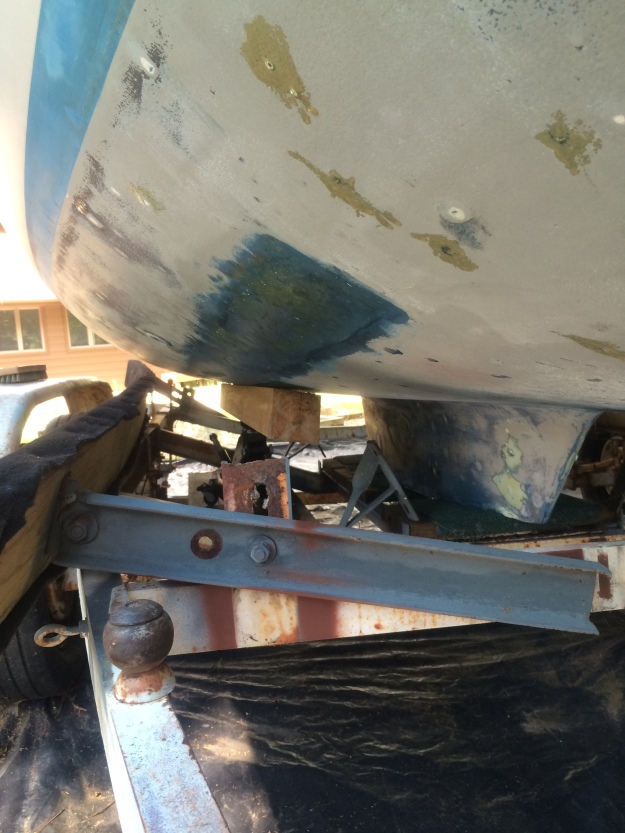Time required for this task: Days and weeks of part-time work for us to clean and prepare the bottom of the boat. Had we been able to make it a concentrated effort, we could have done this in about twelve six hour work days.
So far, this has been the most difficult and time consuming task on the sailboat. Before you decide to tackle this job, research the Internet. There is a lot of information about removing old bottom paint. It is toxic, copper based, which is a heavy metal. You will need to wear protective clothing and eye protection.
We used two gallons of CM-15, a two-part epoxy, for the barrier coats. We could have used any number of barrier coat products, but CM-15 can be applied in hotter temperatures and is for hulls that can flex.
Before we could apply the barrier coat, we had to clean the hull and sand wet sand it with 80 grit sand paper. Below are photos of what the bottom looked like before we started cleaning.
We used a gasoline engine powered portable power washer to remove the old bottom paint. The boat had been in the water for seven years when we purchased it. Had we power washed it when it first came out of the water, all of the bottom paint would have easily been washed off. We waited two years to start cleaning and we had to power wash the bottom several times and use brushes and 80 grit sand paper to remove all of the bottom paint down to the old barrier coating.






This photo shows how we painted underneath the bunks. We lowered the bunks and supported the boat with a 4X4 post on top of a hydraulic jack. This photo shows the difference between the old bottom paint and the old epoxy barrier coat ( Gray color ). We used two part epoxy to cover the places where we used a grinder to open the blisters. We used a straight edge to level it and then after it hardened we use an air sander to smooth them out.
Below are photos that show what the bottom looked like after power washing and sanding.


Once the oil paint was removed we found more blisters and had to repair them. We used an air-powered sander to remove the raised part of the blisters and cut back until we had solid fiberglass or gellcoat. Only one blister used a liquid while we were grinding out the blisters.
When that happens, you should allow that blister to dry completely before going to the next step. Drying may require days. Below is a photo of blisters we found around the stub keel. The photo shows what they looked like after we used the small air-powered sander to remove the loose fiberglass. The blisters in the photo were ready for the next step. We mixed some two part no-blush epoxy and applied it to the areas shown making sure to extend outward around the blistered areas so they were completely covered. We did this to all of the blisters on the bottom and waited 24 hours for the epoxy to harden.

The photos below show the bottom after the first new coat of barrier paint had been applied. The next day, we realized we had a major problem. It was not dry and sticky to the touch. It should have been dry to the touch in five hours. We contacted the manufacturer and he said we did not mix it correctly. We told him we followed the instructions on the can. He quit responding after my son sent him a photo of the instructions on the can.





Notice the area under the bunks. We had to figure out how to get to that area so we could paint it. We found that the stub keel was strong enough to support the boat. so we removed one bunk at a time, after we strapped both sides of the boat and added boards under the rub rail to keep it from rolling over. That worked and the boat was steady and never moved.
Four days, later, the first barrier coat was still not completely dry on about 40 percent of the bottom. We posted our dilemma on Sailboatowners ( dot ) com and got some suggestions. We tried removing the tacky epoxy with de-natured alcohol, Ascentone, and a paint scraper so we could start over. This did not work. All we got off was a black stain. The epoxy would not come off. One person suggested we try a second coat and see if the hardening process would restart.
We did a test coat and the next day, that section was dry. Either one of two things happened. The hardening process restarted and the two coats chemically bonded or the second coat encapsulated the first coat and stuck to to it. We mixed a new batch of CM-15 and applied it to the boat. It was dry to the touch in five hours.
Below are the photos of the test area to see if the second coat idea would work.


Once we realized that worked, we mixed a new batch of CM-15 and applied it to the whole bottom.


Below is a photo of the third and final barrier coat we applied. Notice both bunks were removed to allow access beneath the bunk area for painting. We used two straps on each side and 2 x 8 boards secured beneath the rub rails to keep the boat from rolling over. The boat never moved, since the stub keel is twelve inches wide and capable of supporting the entire weight of the boat.

Next up is Bottom Painting the Sailboat Part 2 of 2 where we applied the latex primer coat before applying the final 100 percent acrylic top coat.
Thank you for stopping by our blog. Happy sailing.












































































